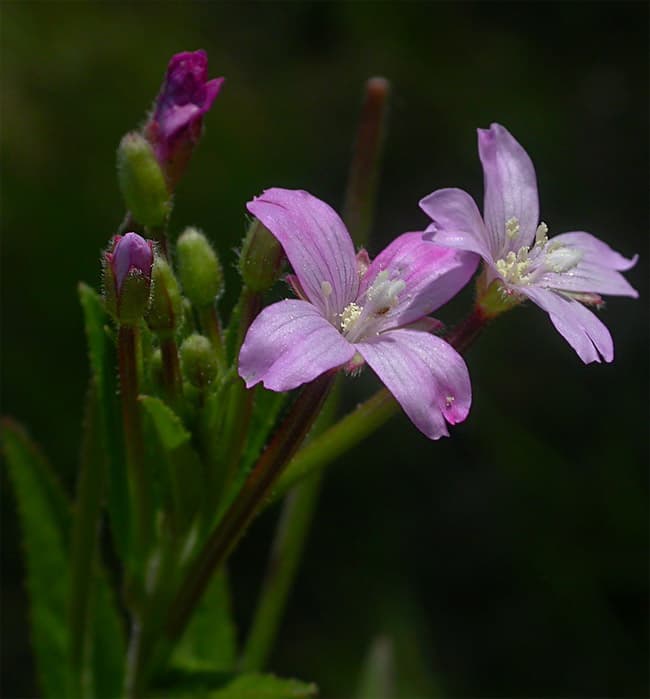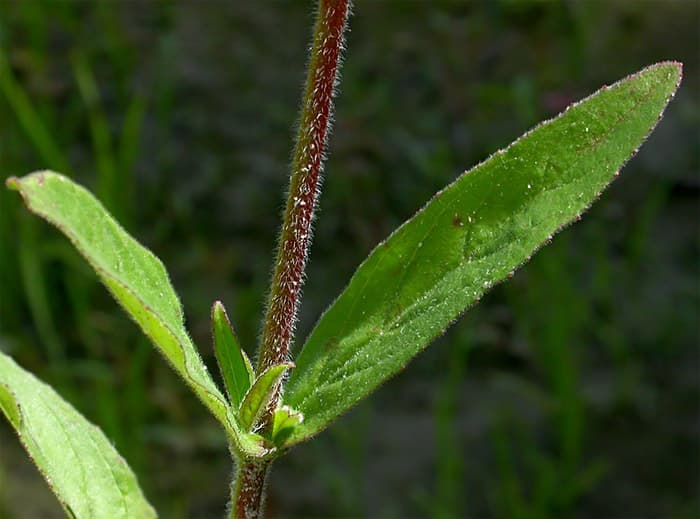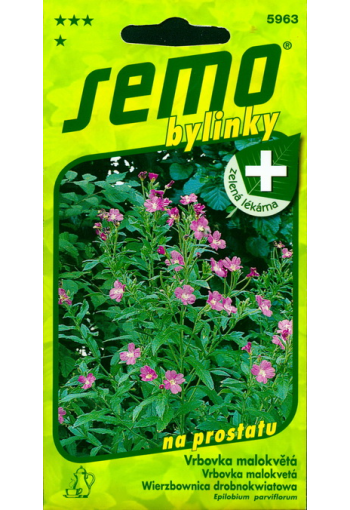Ex Tax: 1.41€
Parts Used: above-ground part of the plant.
Pharmacy name: fireweed herb - Epilobii herba (formerly: Herba Epilobii).
A perennial plant, 15-60 cm tall, with a rhizome. The erect round stem is covered with protruding hairs. The leaves are elongated or ovate-lanceolate. Seeds with a small hairy tuft. Blooms from July to September. It grows most often in clumps along the banks and ditches, in damp forests and clearings, and sometimes in wastelands and in gardens near hedges.
Collection and preparation. Flowering plants are harvested, cut close to the ground and dried in bunches in the sun or in a ventilated place.
Active ingredients: beta-sitosterol, flavonoids and tannins.
Healing action and application. Fireweed small-flowered is recommended for diseases of the prostate gland. You can often even hear that it cures prostate cancer. Such a statement is devoid of any grounds, even with benign diseases of the prostate, this medicinal plant, at best, only helps a little. Its operation is currently being re-examined. In any case, the use of this remedy, if the doctor permits, is welcome.
Fireweed tea: 2 teaspoons topped with herbs, pour 1/4 litre of boiling water and let it brew for 15 minutes. Dosage: 2 cups of tea per day.


Smallflower Hairy Willowherb. Bot. syn.: Chamaenerion parviflorum.
Do not confuse small-flowered fireweed (Epilobium parviflorum) with narrow-leaved fireweed and popularly known as Rosebay willowherb (Epilobium angustifolium).
Here is how the famous healer from Austria Maria Treben writes about him (her book “Health from a pharmacy given to us by the Lord God. Advice and experience in herbal treatment”, which has already been translated into 18 languages).
"Fireweed, which until now was not widely known as a medicinal plant and was not mentioned in any popular herbalist, only after being presented in the first edition of my book, went on a victorious march as a remedy for prostatitis. Very soon it became known in Europe and beyond. not least because it has helped so many people get rid of the above disease. Recently it has been mentioned in herbal books and magazines.
Due to the fact that there are a lot of varieties of fireweed, you can get a little confused, but medicinal fireweed of all varieties can be recognized by small flowers - from reddish, pale pink to almost white. These flowers sit like carnations on long, narrow pods, from which, when they open, seeds appear like white cottony hairs.
In Tyrol, fireweed is well known, surprisingly, under the name "women's hair." At the healing fireweed, a stem with leaves and flowers is harvested. At the same time, you need to know that the stem should be broken off in the middle (it is easy to break off) so that the plant can then throw outside shoots. The collected raw materials must be immediately finely chopped. Fireweed, even with severe forms of the disease, drinks no more than two cups a day: one in the morning on an empty stomach, and the second in the evening. But that doesn't mean you shouldn't see a doctor. This must be done in any case.
Two types of fireweed, which are unlikely to be confused with others (small-flowered fireweed species) - cannot be collected:
1. this is a fireweed with hard hairs or villi (shaggy) - Epilobium hirsutum;
2. and forest fireweed - Epilobium angustifolium.
The first, hairy, have flowers the size of a thumbnail and is purplish red. It grows mainly in whole colonies of bushes, reaching 150 cm in height, on the shallows near the water; stems and leaves are fleshy and hairy on the underside. Forest fireweed also reaches a height of 150 cm and is often found in forest thickets, on the edges of the forest, in cutting areas, and in raspberries. Large purple-red flowers grow in pyramidal long sparse clusters on a reddish stem. Its popular name - Unholdenkraut ("devil's grass", "devil's grass") - directly says that it cannot be used for any diseases.
I was a young woman when my father-in-law died in the prime of his life from an abnormally enlarged prostate gland. A neighbour who was well versed in herbs showed me a small-flowered fireweed and said: “If your father-in-law had drunk tea from this plant, he would still be alive today. You are a young woman and will be able to help many more with this plant.” But, as is often the case when we are young and healthy, I forgot about him. But my mother didn't forget that! She collected small-flowered fireweed every year and helped many who suffered from kidney and bladder diseases. In the summer of 1961, my mother died, and that summer I forgot about harvesting fireweed. In the waiting room of my doctor, I heard that one of my acquaintances was in this hospital, hopelessly ill with bladder cancer. “No,” I exclaimed, “this man must not die!” And at the same time, I thought about Cyprus. The doctor, although he had a good attitude towards herbs, believed that in this case, nothing could help the patient. But I didn’t prepare the fireweed and thought with horror that now, in mid-October, everything, probably, had already faded and withered. And yet I went for fireweed. I knew one place where it bloomed in summer. I found only a few yellowed stalks, which, nevertheless, I chopped finely and sent to the wife of a seriously ill person. She gave him 2 cups of tea a day, one in the morning and one in the evening, and after 14 days I learned from the doctor who called me on the phone that the patient's condition had improved significantly. He said, laughing: “Still, your weed helps!” Since then, I have been able to help hundreds and hundreds of patients, one pharmacist in Munich showed me an old pharmacy book, where fireweed was listed as a medicinal plant around 1880. Then the chemicals completely replaced it. Now fireweed is again becoming known in all segments of the population thanks to my reports, publications and the exchange of herbs.
My advice is resonating with many. Wherever my husband and I travel - in the mountains or on forest paths, along the banks of streams or clearings, even in the vicinity of Linz - we find, to our joy, fireweed, to which people reacted consciously: only medium shots were taken. After that, the plant shoots 2-3 more times. If the root is not damaged, then the next year the fireweed grows again.
From letters to me, I am happy to learn that many people grow in the garden not only strawberries, vegetables and ornamental shrubs but also small-flowered fireweed. Previously, it was disposed of like a weed.
Here is a letter to me from the Schwarzwald: “My mother-in-law, who was treated for cancer of the uterus with radiation, suffered from this bowel and bladder. She had such pain in her bladder that the doctor had to give her morphine. And according to the drawing in your book, we were looking for small-flowered fireweed and found it. A week after the start of taking fireweed tea, the pain disappeared. These are miracles from the pharmacy that the Lord will give us!”
Many prostate sufferers can recover from small-flowered fireweed without even undergoing surgery. And if it has already been done, then fireweed tea will relieve the burning sensation and other unpleasant phenomena that appear after the operation. But in any case, you need to see a doctor ... "











